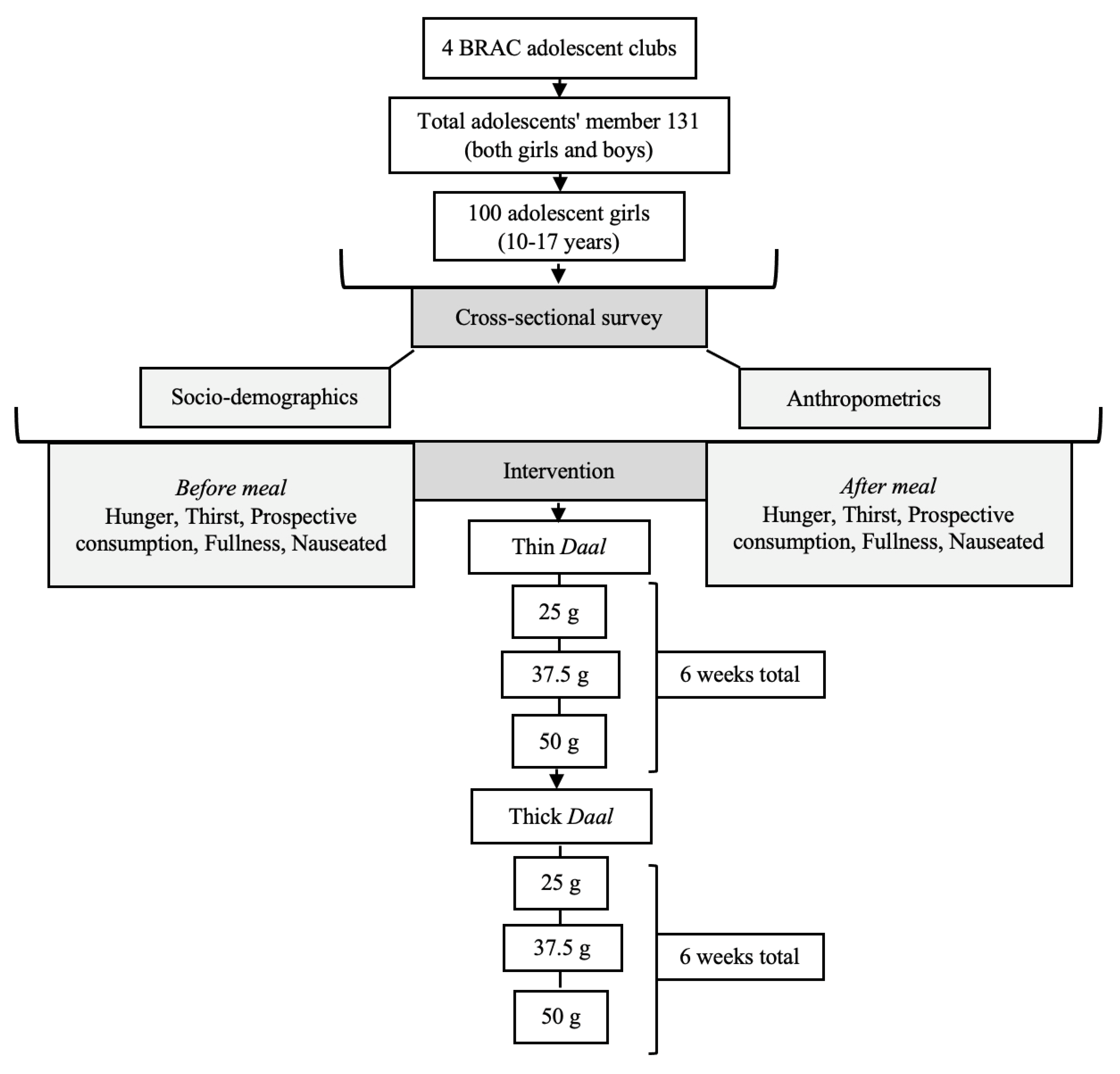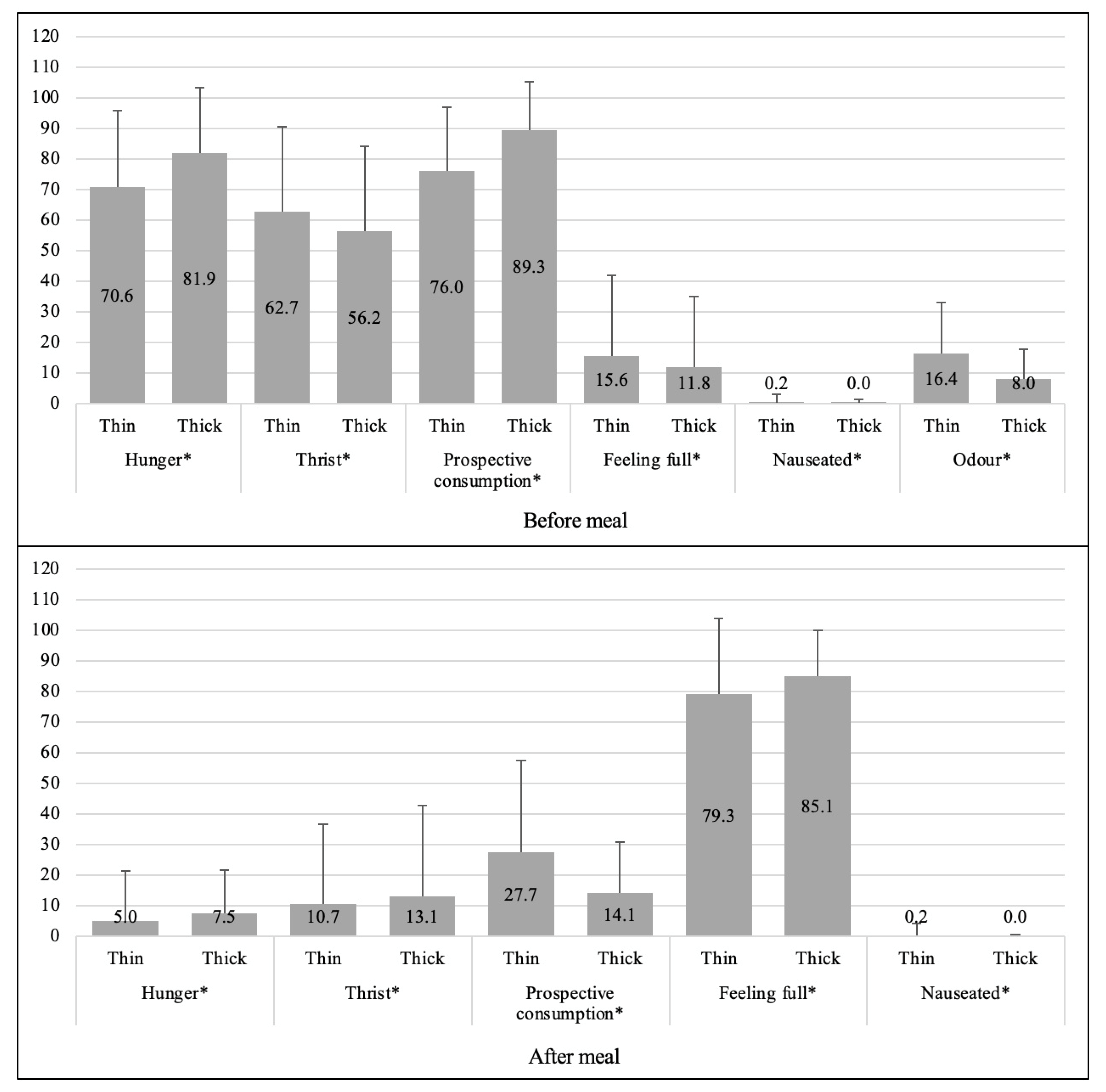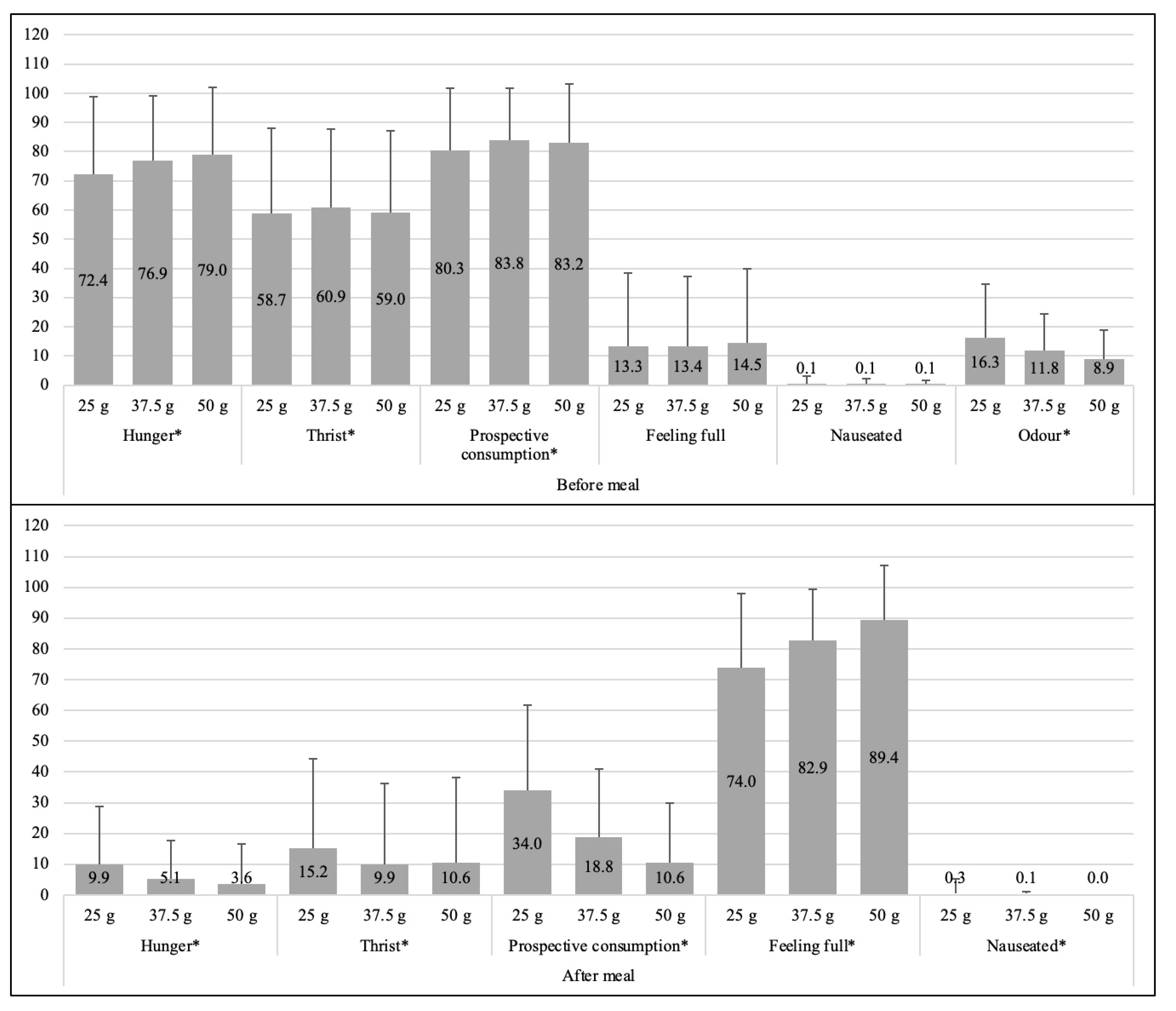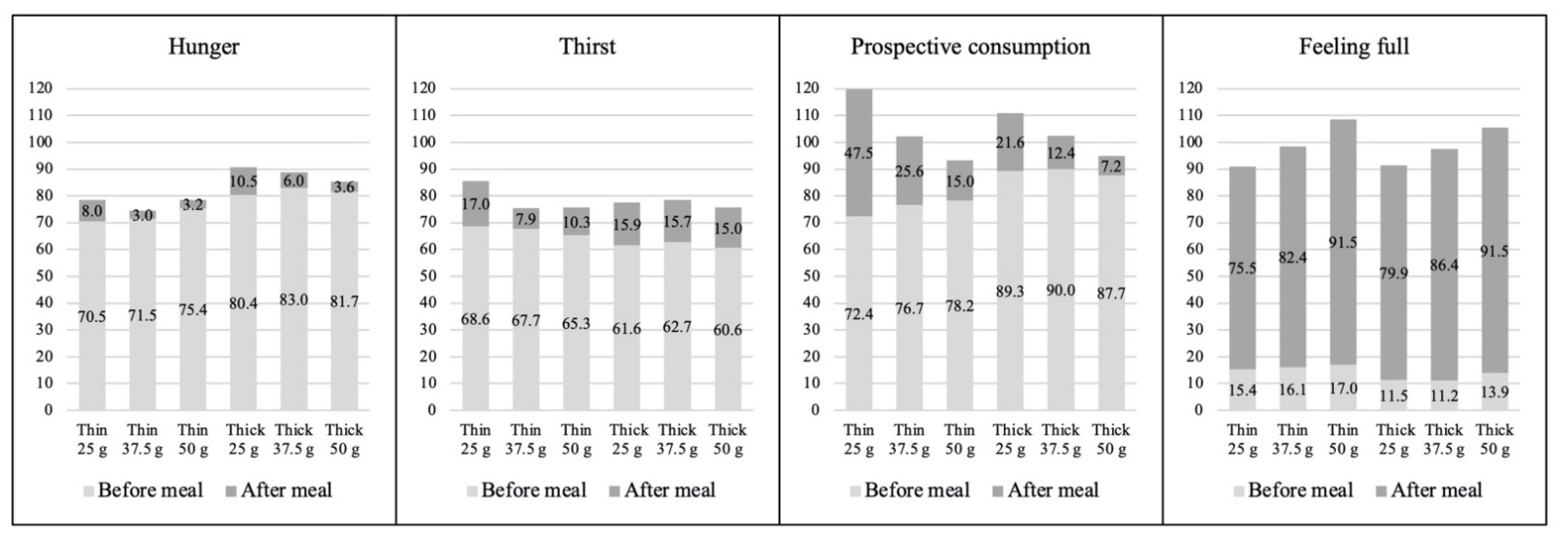Determination of an Acceptable Portion Size of Daal for a Bangladeshi Community-Based Iron Intervention in Adolescent Girls: A Feasibility Study
Abstract
1. Introduction
2. Materials and Methods
2.1. Study Setting and Population
2.2. Study Design and Trial
2.3. Study Variables and Outcome Measurements
2.4. Statistical Analysis
3. Results
3.1. Differences in Preference by Cooking Preparation
3.2. Difference in Preference by Portion Size
3.3. Difference in Preferences by Combined Portion Size and Cooking Preparation
3.4. Residual Amount and Estimated Iron Intake
4. Discussion
5. Conclusions
Author Contributions
Funding
Institutional Review Board Statement
Informed Consent Statement
Data Availability Statement
Acknowledgments
Conflicts of Interest
References
- World Health Organization. The Global Prevalence of Anaemia in 2011; World Health Organization: Geneva, Switzerland, 2011. [Google Scholar]
- World Health Organization. Global Health Estimates 2018: Disease Burden by Cause, Sex, by Country and Region, 2000–2016; World Health Organization: Geneva, Switzerland, 2018. [Google Scholar]
- ICDDRB; UNICEF Bangladesh; GAIN; Institute of Public Health and Nutrition. National Micronutrients Status Survey 2011–12: Final Report; ICDDRB: Dhaka, Bangladesh, 2013. [Google Scholar]
- Miller, J.L. Iron deficiency anemia: A common and curable disease. Cold Spring Harb. Perspect. Med. 2013, 3. [Google Scholar] [CrossRef]
- Thavarajah, D.; Thavarajah, P.; Sarker, A.; Vandenberg, A. Lentils (Lens culinaris medikus subspecies culinaris): A whole food for increased iron and zinc intake. J. Agric. Food Chem. 2009, 57, 5413–5419. [Google Scholar] [CrossRef]
- Thavarajah, D.; Thavarajah, P.; Wejesuriya, A.; Rutzke, M.; Glahn, R.P.; Combs, G.F.; Vandenberg, A. The potential of lentil (Lens culinaris L.) as a whole food for increased selenium, iron, and zinc intake: Preliminary results from a 3 year study. Euphytica 2011, 180, 123–128. [Google Scholar] [CrossRef]
- Das, J.K.; Salam, R.A.; Kumar, R.; Bhutta, Z.A. Micronutrient fortification of food and its impact on woman and child health: A systematic review. Syst. Rev. 2013, 2, 1. [Google Scholar] [CrossRef]
- Erskine, W.; Sarker, A.; Kumar, S. Crops that feed the world 3. Investing in lentil improvement toward a food secure world. Food Secur. 2011, 3, 127–139. [Google Scholar] [CrossRef]
- Beyer, P.; Al-Babili, S.; Ye, X.; Lucca, P.; Schaub, P.; Welsch, R.; Potrykus, I. Golden Rice: Introducing the beta-carotene biosynthesis pathway into rice endosperm by genetic engineering to defeat vitamin A deficiency. J. Nutr. 2002, 132, 506S–510S. [Google Scholar] [CrossRef]
- Lucca, P.; Hurrell, R.F.; Potrykus, I. Fighting iron deficiency anemia with iron-rich rice. J. Am. Coll. Nutr. 2002, 21, 184S–190S. [Google Scholar] [CrossRef]
- Ye, X.; Al-Babili, S.; Klöti, A.; Zhang, J.; Lucca, P.; Beyer, P.; Potrykus, I.; Sommer, A.; West, K.P.; Howard, G.R.; et al. Engineering the Provitamin A (β-Carotene) Biosynthetic Pathway into (Carotenoid-Free) Rice Endosperm. Science 2000, 287, 96–305. [Google Scholar] [CrossRef] [PubMed]
- BRAC. BRAC Ranked Top Global NGO of 2018. Available online: http://www.brac.net/latest-news/item/1145-brac-ranked-top-global-ngo-of-2018 (accessed on 5 July 2018).
- Dibari, F.; Bahwere, P.; Huerga, H.; Irena, A.H.; Owino, V.; Collins, S.; Seal, A. Development of a cross-over randomized trial method to determine the acceptability and safety of novel ready-to-use therapeutic foods. Nutrition 2013, 29, 107–112. [Google Scholar] [CrossRef] [PubMed]
- Podder, R.; Tar’an, B.; Tyler, R.; Henry, C.; DellaValle, D.M.; Vandenberg, A. Iron fortification of lentil (lens culinaris medik.) to address iron deficiency. Nutrients 2017, 9, 863. [Google Scholar] [CrossRef] [PubMed]
- Yunus, F.M.; Jalal, C.; Afsana, K.; Podder, R.; Vandenberg, A.; DellaValle, D.M. Iron-fortified lentils to improve iron (Fe) status among adolescent girls in Bangladesh—Study protocol for a double-blind community-based randomized controlled trial. Trials 2019, 20, 251. [Google Scholar] [CrossRef]
- ’Lohman, T.; ’Roche, A.; ’Martorell, R. Anthropometric Standardization Reference Manual; Human Kinetics: Champaign, IL, USA, 1988. [Google Scholar]
- Bacopoulou, F.; Efthymiou, V.; Landis, G.; Rentoumis, A.; Chrousos, G.P. Waist circumference, waist-to-hip ratio and waist-to-height ratio reference percentiles for abdominal obesity among Greek adolescents. BMC Pediatr. 2015, 15. [Google Scholar] [CrossRef]
- World Health Organization. Physical Status: The Use and Interpretation of Anthropometry; World Health Organization: Geneva, Switzerland, 1995. [Google Scholar]
- National Health and Nutrition Examination Survey (NHANES). Anthropometry Procedures Manual; NHANES: Atlanta, GA, USA, 2007.
- Wewers, M.E.; Lowe, N.K. A critical review of visual analogue scales in the measurement of clinical phenomena. Res. Nurs. Health 1990, 13, 227–236. [Google Scholar] [CrossRef] [PubMed]
- Flint, A.; Raben, A.; Blundell, J.E.; Astrup, A. Reproducibility, power and validity of visual analogue scales in assessment of appetite sensations in single test meal studies. Int. J. Obes. 2000, 24, 38–48. [Google Scholar] [CrossRef]
- Parker, B.A.; Sturm, K.; MacIntosh, C.G.; Feinle, C.; Horowitz, M.; Chapman, I.M. Relation between food intake and visual analogue scale ratings of appetite and other sensations in healthy older and young subjects. Eur. J. Clin. Nutr. 2004, 58, 212–218. [Google Scholar] [CrossRef]
- Sadoul, B.C.; Schuring, E.A.H.; Symersky, T.; Mela, D.J.; Masclee, A.A.M.; Peters, H.P.F. Measuring satiety with pictures compared to visual analogue scales. An exploratory study. Appetite 2012, 58, 414–417. [Google Scholar] [CrossRef] [PubMed]
- Lindeman, A.; Huang, M.; Dawkins, E. Using the Visual Analog Scale (VAS) to measure perceived hunger and satiety at various mealtimes and environments. J. Acad. Nutr. Diet. 2016, 116, A99. [Google Scholar] [CrossRef]
- Institute of Medicine. Dietary Reference Intakes; National Academies Press: Washington, DC, USA, 2003; ISBN 0309091322. [Google Scholar]
- Podder, R.; DellaValle, D.M.; Tyler, R.T.; Glahn, R.P.; Tako, E.; Vandenberg, A. Relative bioavailability of iron in Bangladeshi traditional meals prepared with iron-fortified Lentil Dal. Nutrients 2018, 10, 354. [Google Scholar] [CrossRef] [PubMed]
- DellaValle, D.M.; Glahn, R.P. Differences in relative iron bioavailability in traditional Bangladeshi meal plans. Food Nutr. Bull. 2014, 35, 431–439. [Google Scholar] [CrossRef]
- Ginanjar, E.; Indrawati, L.; Setianingsih, I.; Atmakusumah, D.; Harahap, A.; Timan, I.; Marx, J. Iron absorption in iron-deficient women, who received 65 mg Fe with an Indonesian breakfast, is much better from NaFe(III)EDTA than from Fe(II)SO4, with an acceptable increase of plasma NTBI. A randomized clinical trial. Pharmaceuticals 2018, 11, 85. [Google Scholar] [CrossRef] [PubMed]
- Dueik, V.; Chen, B.K.; Diosady, L.L. Iron-polyphenol interaction reduces iron bioavailability in fortified tea: Competing complexation to ensure iron bioavailability. J. Food Qual. 2017, 2017. [Google Scholar] [CrossRef]
- Alam, N.; Roy, S.K.; Ahmed, T.; Ahmed, A.M.S. Nutritional status, dietary intake, and relevant knowledge of adolescent girls in rural Bangladesh. J. Heal. Popul. Nutr. 2010, 28, 86–94. [Google Scholar] [CrossRef] [PubMed]
- Sarker, A.; Erskine, W.; Abu, M.; Matiur, B.M.; Afzal, R.M.A.; Saxena, M.C. Lentil Improvement in Bangladesh: A Success Story of Fruitful Partnership between the Bangladesh Agricultural Research Institute and International Center for Agricultural Research in the Dry Areas; Asia-Pacific Association of Agricultural Research Institutions (APAARI): Bangkok, Thailand, 2004; Available online: http://www.apaari.org/web/wp-content/uploads/2009/05/ss_2004_01.pdf (accessed on 4 September 2020).





| Sl. No | Thick Lentil Cooking Preparation and Amount (Based on 100 g of Uncooked Daal) | Thin Lentil Cooking Preparation and Amount (Based on 100 g of Uncooked Daal) | ||
|---|---|---|---|---|
| Ingredients | Amount (g) | Ingredients | Amount (g) | |
| 1 | Daal | 100 | Daal | 100 |
| 2 | Turmeric | 5 | Turmeric | 3 |
| 3 | Chopped onion | 40 | Chopped onion | 40 |
| 4 | Garlic | 8 | Garlic | 8 |
| 5 | Green chili | 3 smalls | Green chili | 3 smalls |
| 6 | Water | 700 mL | Water | 1.5 L |
| 7 | Salt | 1.5 teaspoonful | Salt | 1.5 teaspoonful |
| 8 | Soyabean oil | 10 teaspoonfuls | Soyabin oil | 6 teaspoonfuls |
| 9 | Bay Leaf (Tejpata) | 1 (small) | Bay Leaf (Tejpata) | 1 (small) |
| 10 | Time | 18 min | Time | 53 min |
| Weight after cooking: 585 g | Weight after cooking: 1166 g (1.166 Kg) | |||
| Variables | Adolescent Girls (Age 10–17 Years) % |
|---|---|
| Age (mean ± SD) | 12.9 ± 2.0 |
| Age of menarche (mean ± SD) | 12.1 ± 0.9 |
| Menstruation (Yes) | 64 |
| Menstrual regularity (once every month) | 54 |
| Marital status (No) | 97 |
| Education (Secondary) | 67 |
| Socioeconomic status | |
| House wall (Brick/Cement) | 52 |
| House roof (Tin) | 95 |
| House floor (Brick/Cement) | 82 |
| Electricity | 98 |
| Anthropometric | |
| Height; cm (mean ± SD) | 146.8 ± 10.0 |
| Weight; kg (mean ± SD) | 37.3 ± 9.2 |
| Waist circumference; cm (mean ± SD) | 64.9 ± 7.0 |
| Hip circumference; cm (mean ± SD) | 78.1 ± 7.9 |
| Mid-upper arm circumference (MUAC); cm (mean ± SD) | 20.8 ± 3.2 |
| Body mass index (BMI) | 17.1 ± 3.0 |
| Consumption Daal Conditions | Served Daal (g) | Residual Daal (g) | Consumed Daal (Cooked Amount) (g) | Iron Contents in Consumed Daal ** (Mg) |
|---|---|---|---|---|
| Thin 25 g | 274.2 ± 2.2 * | 29.0 ± 4.4 * Ψ | 245.0 ± 4.9 * | 4.5 ± 0.01 * |
| Thin 37.5 g | 331.6 ± 1.5 * | 36.2 ± 5.5 * Ψ | 294.8 ± 6.3 * | 6.7 ± 0.1 * Ψ |
| Thin 50 g | 431.2 ± 1.6 * | 61.5 ± 8.1 * | 369.2 ± 8.2 * | 8.6 ± 0.1 * Φ |
| Thick 25 g | 157.9 ± 0.7 * | 4.9 ± 1.2 * | 153.1 ± 1.6 * | 4.9 ± 0.0 * |
| Thick 37.5 g | 202.7 ± 1.5 * | 17.5 ± 3.0 * | 185.2 ± 2.4 * | 6.9 ± 0.1 * Ψ |
| Thick 50 g | 256.4 ± 1.9 * | 27.1 ± 4.6 * Ψ | 229.3 ± 4.5 * | 9.0 ± 0.2 * Φ |
Publisher’s Note: MDPI stays neutral with regard to jurisdictional claims in published maps and institutional affiliations. |
© 2021 by the authors. Licensee MDPI, Basel, Switzerland. This article is an open access article distributed under the terms and conditions of the Creative Commons Attribution (CC BY) license (http://creativecommons.org/licenses/by/4.0/).
Share and Cite
Yunus, F.M.; Jalal, C.; Zello, G.A.; Afsana, K.; Vandenberg, A.; DellaValle, D.M. Determination of an Acceptable Portion Size of Daal for a Bangladeshi Community-Based Iron Intervention in Adolescent Girls: A Feasibility Study. Nutrients 2021, 13, 1080. https://doi.org/10.3390/nu13041080
Yunus FM, Jalal C, Zello GA, Afsana K, Vandenberg A, DellaValle DM. Determination of an Acceptable Portion Size of Daal for a Bangladeshi Community-Based Iron Intervention in Adolescent Girls: A Feasibility Study. Nutrients. 2021; 13(4):1080. https://doi.org/10.3390/nu13041080
Chicago/Turabian StyleYunus, Fakir Md., Chowdhury Jalal, Gordon A. Zello, Kaosar Afsana, Albert Vandenberg, and Diane M. DellaValle. 2021. "Determination of an Acceptable Portion Size of Daal for a Bangladeshi Community-Based Iron Intervention in Adolescent Girls: A Feasibility Study" Nutrients 13, no. 4: 1080. https://doi.org/10.3390/nu13041080
APA StyleYunus, F. M., Jalal, C., Zello, G. A., Afsana, K., Vandenberg, A., & DellaValle, D. M. (2021). Determination of an Acceptable Portion Size of Daal for a Bangladeshi Community-Based Iron Intervention in Adolescent Girls: A Feasibility Study. Nutrients, 13(4), 1080. https://doi.org/10.3390/nu13041080








